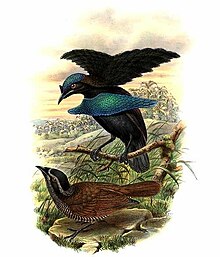Greater lophorina: Difference between revisions
No edit summary |
Undid revision 527763342 by 204.100.189.194 (talk) |
||
| Line 20: | Line 20: | ||
==Description== |
==Description== |
||
The male is black with an iridescent green crown, blue-green breast shield and a long velvety black erectile cape covering his back. The female is a reddish-brown bird with brownish barred buff below. The young is similar to the female. |
The male is black with an iridescent green crown, blue-green breast shield and a long velvety black erectile cape covering his back. The female is a reddish-brown bird with brownish barred buff below. The young is similar to the female. |
||
== Courtship display == |
== Courtship display == |
||
Revision as of 16:49, 10 January 2013
| Greater lophorina | |
|---|---|

| |
| Scientific classification | |
| Kingdom: | |
| Phylum: | |
| Class: | |
| Order: | |
| Family: | |
| Genus: | Lophorina Vieillot, 1816
|
| Species: | L. superba
|
| Binomial name | |
| Lophorina superba (Pennant, 1781)
| |
The Superb Bird-of-paradise (Lophorina superba), also known as the Smiley Bird Of Paradise, is a small, approximately 26 cm long, passerine bird of the Paradisaeidae (Birds of Paradise) family. It is the only member in the genus Lophorina. The Superb Bird-of-paradise is distributed throughout rainforests of New Guinea.
Description
The male is black with an iridescent green crown, blue-green breast shield and a long velvety black erectile cape covering his back. The female is a reddish-brown bird with brownish barred buff below. The young is similar to the female.
Courtship display
The species has an unusually low population of females, and competition amongst males for mates is intensely fierce. This has led the species to have one of the most bizarre and elaborate courtship displays in the avian world. After carefully and meticulously preparing a "dance floor" (even scrubbing the dirt or branch smooth with leaves), the male first attracts a female with a loud call. After the curious female approaches, his folded black feather cape and blue-green breast shield springs upward and spreads widely and symmetrically around its head, instantly transforming the frontal view of the bird into a spectacular ellipse-shaped creature that rhythmically snaps its tail feathers against the ground while hopping in frantic circles around the female. While this display is in effect, the blue plumage is in a pattern similar to a cartoon face. Even despite the elaborate display, the average female rejects 15-20 potential suitors before consenting to mate.
Status
Although heavily hunted for its plumes, the Superb Bird-of-paradise is one of the most common and widespread birds of paradise in New Guinea forests. The Superb Bird-of-paradise is evaluated as Least Concern on the IUCN Red List of Threatened Species.[1] It is listed on Appendix II of CITES.
References
- ^ a b Template:IUCN

